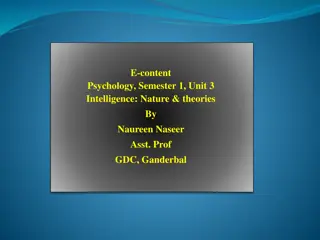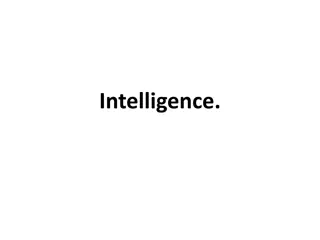Theories of Intelligence: Monarchie vs. Spearman's Two-Factor Theory
The Monarchie Theory of Intelligence posits a single factor of intelligence, while Spearman's Two-Factor Theory divides intelligence into a general ability (G-factor) and specific abilities (S-factors). The implications of these theories on educational practices are discussed, shedding light on the nature of intelligence.
- Intelligence Theories
- Monarchie Theory
- Spearmans Theory
- Educational Implications
- Psychometric Foundation
Download Presentation

Please find below an Image/Link to download the presentation.
The content on the website is provided AS IS for your information and personal use only. It may not be sold, licensed, or shared on other websites without obtaining consent from the author. Download presentation by click this link. If you encounter any issues during the download, it is possible that the publisher has removed the file from their server.
E N D
Presentation Transcript
Theories of Intelligence EDNH 201 PSYCHOLOGICAL FOUNDATION OF EDUCATION MONIKHA SAIKIA ASSISTANT PROFESSOR DEPARTMENT OF EDUCATION
Monarchie Theory of Intelligence This theory was put forward by Johnson and Stern According to them, intelligence is a single unit or capacity to solve all types of problems. Intelligence consists of one factor. This theory holds that intelligence consist of one factor; simply a fund of intellectual competency, which is universal for all the activities of the individual.
Cont According to this theory, if one has a fund of intelligence he can utilize it to any area of his life. But in our practical life we see contrary to this. It has some draw backs such as some situation it does not suit well. A child may have good intelligence of Math but may be poor in Civics. A genius mathematics professor may be absent minded or socially ill-adjusted.
Spearmans Two-Factor Theory: Developed in 1904 by an English psychologist, Charles Spearman. According to him intellectual abilities are comprised of two factors, namely; the general ability known as G-factor the specific Abilities known as S-factors. The total intelligence of the individual is the sum total of the G-factor and the S-factors. The performance of a particular task depends on the G factor or general ability and the particular S factor or specific ability.
Vocabulary S1 G Arithmetic Reasoning S4 Reading Comprehension S2 Computation S3 Fig: Spearman s Two-Factor Theory
Characteristics of G Factor ( General mental ability) It is universal inborn ability. It is general mental energy. It is constant. The amount of g differs from individual to individual. It is used in every activity of life. Greater the g in an individual, greater is his success in life.
Characteristics of S Factor ( Special mental ability) It is learned and acquired in the environment. It varies from activity to activity in the same individual. Individuals differ in the amount of S ability
Educational Implications and relevance of Spearman s Two Factor Theory: The theory gives a better insight to the teacher about the nature of intelligence. The general ability differs from individual to individual. The specific abilities also differ from individual to individual. S factor varies in degrees. Therefore, it can be modified by learning or habitual training
Cont.. A child requires different amounts of G and S factors for achieving success in different Subjects. We require a high quality of G factor for our success in life. Both G and S have a high correlation. This theory could be used to guide, construction of a set of ability test.
Thurstone's Group Factor Theory Developed by an American psychologist psychologist, Louis Leon Thurstone. According to this theory, Intelligence is a cluster of abilities. Thurstone says intelligence is not determined primarily by simple, general factor but a variable number of similarity broad factors. His theory also called the Theory of Primary Mental Abilities. He pointed out that there were Seven Primary Mental Abilities and later on added two more.
Verbal Word Fluency comprehension Spatial visualization Perceptual speed 7 Primary Ability Numerical Ability Reasoning Memory Fig: Group factory of intelligence
They are: Verbal comprehension Factor (V) This factor involves a person s ability to understand and utilise verbal ideas. It can be assessed through tests such as vocabulary, jumble comprehension. word and reading
Word fluency Factor (W) This ability is involved in rapidly producing words, sentences, and other verbal material. It is measured by tests such as one that requires the examinee to produce as many words as possible beginning with a particular letter in a short amount of time.
Perceptual speed Factor (P) This ability is involved in proofreading and in rapid recognition of letters and numbers.
Numerical Ability (N) Ability to do numerical calculations rapidly and accurately. It can be measured by checking the accuracy and speed of the person in solving various arithmetic problems.
Memory Factor (M) Involving ability to memorize quickly. It means the ability to recall and associate previously learned memorize quickly. items effectively or
Reasoning (R) To be able to perceive and utilise abstract relationships. To be able to put together past experiences in the solution of new problems.
Spatial visualization Factor (S) This ability is involved in visualizing the geometric pattern such as shapes, rotations of objects, and how pieces of a puzzle fit together. An example of a test would be the presentation of a geometric form followed by several other geometric forms. Each of the forms that follows the first is either the same rotated by some rigid transformation or the mirror image of the first form in rotation. The examinee has to indicate which of the forms at the right is a rotated version of the form at the left, rather than a mirror image.
Guildfords Structure of Intelligence (SoI Model) This theory was developed by J.P. Guilford in 1966. He suggests that there are three basic parameters along which any intellectual activity takes place. These are: 1. Operations the act of thinking 2. Contents the terms in which we think, and 3. Products the ideas we come up with.
Operations: It consists of five major groups of intellectual abilities Cognition: It refers to discovery, rediscovery or recognition. Memory: Simply remembering what was once known. Divergent Thinking: This is thinking in different directions, seeking and searching some variety and novelty. Convergent Thinking: This type of thinking, by reasoning, results in useful solution to problems. Evaluation: It is reaching decisions or making judgments about information
Content: It involves five factors: Visual Content: It is concrete material which is perceived through our senses, i.e. size, form, colour, etc. Auditory Content: It consists of language, speech, sounds, music and words Symbolic Content: It is composed of letters, digits, and other conventional signs. Semantic Content: It is in the forms of verbal meanings or ideas which we get from others. Behavioural Content: It means social behaviour in society.
Products: It involved- Units: Understanding the meaning of words, visual, auditory and symbolic units. Classes: It means classification of words and ideas. Relations: It implies discovering relations of words and ideas. Systems: The ability to structure objects in space and to structure symbolic elements and to formulate problems. Transformation: The ability to look into the future lines of development or to suggest changes in the existing situations. Implications: The ability to utilize present information for future ends.
Educational Implications and relevance of Structure of Intellect Theory: It provides knowledge about the specific ability of the students to guide them in right direction. It is useful in finding out the reasons of the unsatisfactory performance of the students in spite of their adequate intelligence. This model points out that for understanding higher mental processes like thinking some drastic modifications could be needed in our curriculum or method of instruction. This model guides us to device enrichment programmes for the gifted children. It is very useful in constructing tests of various types for different age groups. This concept of Guildford will prove useful in our future research in the areas of learning, memory, problem-solving etc. It is very useful for vocational training.























